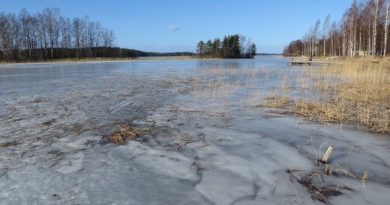N.W.T. communities learning to adapt as heat waves become more common

One mayor says he brought an electric fan with him out on the land for the first time
This summer, the Town of Inuvik, N.W.T. opened an emergency cooling centre for the first time — as a heatwave that swept through much of Western Canada in early August caused multiple days of temperatures over 30 C.
Chairs, games, and water were set up at the curling rink in the Midnight Sun Complex for anyone who needed to cool down. The fire department also organized a pop-up waterpark to help kids stay cool in the heat.
Inuvik hit its highest ever recorded temperature during the heat wave: 34.1 C. Mayor Clarence Wood said it was a wake-up up call.
“I think because of the experience this year, we’ll be better prepared in the future,” he said.
“We’re going to have more of these hot days … in the future. We’re going to have to get a plan of attack together … [and] we’re working on it.”
A growing concern
Communities across the territory are trying to figure out the best ways to minimize the dangers of high temperatures.
Northwest Territories Association of Communities CEO Sara Brown said she’s hearing from community leaders who are increasingly sharing their concerns about heat and their need to support residents accordingly.
The organization, which offers support on climate adaptation projects, initially focused on permafrost melt, erosion, and wildfires, but have now added cooling and clean air shelters to the mix.
Brown said there are unique challenges to building for heat in the north. Even if communities aren’t seeing as high temperatures as in the south, the long summer days mean there are fewer hours for cooling off in the evening. As a result, buildings stay hotter for longer, she said.
“There’s lots of vulnerability there,” Brown said.

Caroline Metz, who studies the impacts of heat on health at the Intact Centre for Climate Adaptation at University of Waterloo, said a complicating factor for N.W.T. when it comes to heat is the simultaneous prevalence of wildfires.
“Heat and wildfire smoke together is, you know, even more problematic [to health],” she said, as people may be forced to choose between letting a breeze in to stay cool or keeping smoke out and getting too hot.
In addition, wildfire conditions can make green cooling solutions like adding shade trees around homes undesirable or even dangerous, Metz said.
Despite these challenges, Metz said there’s lots that N.W.T. communities can do to reduce the health risks associated with heat. This includes adding shutters or shades around windows, educating residents on how to spot heatstroke, and setting up cooling centres.
Finding Solutions
Work to mitigate the impacts of heat has already begun.
Brown said her organization is working with the territory to secure funding for air quality sensors, portable air conditioners, and air purifiers that communities can use to turn existing buildings into clean air and cooling shelters.
The goal was to come up with a solution that wouldn’t require bringing in contractors to complete the work, Brown said.
Communities such as Fort Smith, Gameti, and Norman Wells set up emergency cooling centres during heat waves this year.
In Paulatuk, mayor Ray Ruben said no public buildings have cooling systems. But, he said that when the community was hit by the heatwave in early August, some residents stayed cool by swimming in nearby lakes.
Others, like his family, were camping closer to the coast of the Arctic Ocean, where temperatures were lower. However, Ruben said that for the first time ever, his family brought electric fans for their time out on the land.
“We couldn’t stay outdoors. We had to go into the tents and throw the fans on, and try and keep cool as much as we can,” he said. “That was something I’ve never seen in terms of heat.”
Rapid AC usage can lead to power outages
When it hit 37 C in Fort Good Hope, N.W.T. on Aug. 9, Chief Collin Pierrot said many families went to nearby Rabbitskin River to swim. Things were also made easier by the fact that most residents had portable air conditioning units, Pierrot said.
But they still faced challenges. Neither the band office nor Yamoga Land Corporation office have AC, so both were closed for the day. Workers who were cleaning up the burn area from earlier in the summer also had to be sent home.
During the afternoon, power also went out, rendering fans and ACs useless. The cause of the power outage was a rapid increase in electricity usage and extremely high ambient temperature, according to Northwest Territories Power Corporation.
Pierrot said they were especially concerned about elders, who are more vulnerable to heatstroke and other heat-related illnesses.
“You’re constantly riding around to make sure that everybody’s okay,” he said.
Inuvik Mayor Clarence Wood, said in preparation for next year, he’s working to get funding for AC units for elders and portable pools for kids.
“It’s hard to predict what’s going to come in the future … like every other community in the N.W.T., [we] just go along with what’s to come,” he said.
Related stories from around the North:
Canada: Makivvik launches climate adaptation strategy for Nunavik, Eye on the Arctic
Finland: Finland sees “exceptionally warm” July as global temperatures hit record highs, Yle News
Greenland: Alarming, above-average ice loss in Greenland due to rising temperatures, Eye on the Arctic
Norway: Longyearbyen sees first time ever above 20°C in August, The Independent Barents Observer
Sweden: Another year of shrinking glaciers predicted in Sweden’s Far North, CBC News
United States: Alaska’s North Slope sees record-breaking heat, among state’s other climate oddities, Alaska Public Media



